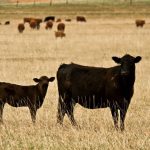
Calving

Reducing disease risk from calving season onwards
Whether it’s scours or Johne’s disease, farmers and ranchers can reduce the chance of transmitting it
With winter calving almost at a close, grassland producers are preparing for their own spring calving season. Chad Ross calves his herd of 800 to 1,100 cows as close to nature as he can. The owner and operator of L-7 Land and Cattle at Estevan, Sask., switched to grassland calving in the mid-2000s. Unless a […] Read more

DNA samples at calving could be new norm
Alberta cattle producer says it’s time for the beef industry to catch up
For seed stock producers, taking DNA samples from newborn calves is becoming more common. Most seed stock herds calve in the winter when the temperature can dip to around -30 C or beyond, snow sparkling under a harsh winter sun. At that time of year, there is already so much to do, and adding another […] Read more

Cameras make a difference in winter calving
Winter calving can be a challenge, but cameras make it easier
Winter is here in full force, and freezing temperatures, large dumps of snow and short days can make winter calving a challenge for seed stock producers. However, technologies such as calving cameras can help make it much easier by saving time and labour. For many, it has become a necessary tool on their operations. Winter […] Read more

Post-calving nutrition to maximize conception rates
Evaluating body condition score can be difficult and requires training
With the current price of calves, targeting high pregnancy rates should be a priority on any cow-calf operation. In addition to remaining pregnant, they must conceive early in the breeding season to maintain a 365-day calving interval and ensure a uniform calf crop. This will promote better returns for the weaned calves and profitability for […] Read more

How to spot respiratory acidosis in a newborn calf
Most beef producers know the frustration that accompanies dealing with the dreaded “dummy calf”. These calves will not suckle, won’t sit up or stand and stare blankly with what seems to be a lack of will and intelligence to survive despite your best efforts. This lack of coordinated movement is often due to respiratory acidosis. […] Read more

Tips for monitoring newborn beef calves
Whether the calf was pulled or born without intervention, this resource can help you decide what to do next
Halley Adams, Lynn Thiessen and Meaghan Nawrot have many things in common, but the most prevalent one is their passion for cattle. As students at the University of Calgary’s faculty of veterinary medicine, that is an important priority. It has brought them together from across the world to Calgary, Alta., to pursue this passion. Adams […] Read more

Changing feeding programs after calving
Nutrition with Barry Yaremcio
Cows and bred heifers require 25 per cent more nutrients after calving than during late pregnancy. Milk production peaks eight weeks after calving. Feed intake increases until 12 weeks after calving. The increased feed intake is the result of the digestive system expanding to fill the space that was occupied by the fetus and reproductive […] Read more

Surviving scours
Prevention is the best medicine, but when you’re in the middle of an outbreak, it’s all about getting through it
Scours. It should be a four-lettered word, for all the misery it causes on cow-calf operations. Even with the best preventative practices, outbreaks can pop up in herds. And in the middle of an outbreak, the focus is on survival, for calves and humans alike. During an outbreak, producers are generally going to see a […] Read more

Post-calving nutrition: Keep your foot on the gas
Meeting the nutritional needs of cows that have recently calved
As we move into spring, calving season is starting for some while for others it is well underway or nearing completion. To this point, your feeding program was likely directed at achieving optimal body condition at calving and ensuring that the nutritional needs of pregnancy were met. The next hurdle is ensuring that your post-calving […] Read more

Tips for raising orphan calves
With calving season in full swing for many ranchers across the Prairies, producers are often dealing with a lot of different challenges — snow, rain, and sometimes, calves that end up orphaned. Abby-Ann Redman, a ruminant nutritionist with Blue Rock Animal Nutrition, says when a rancher ends up with an orphaned calf, the most important thing […] Read more



